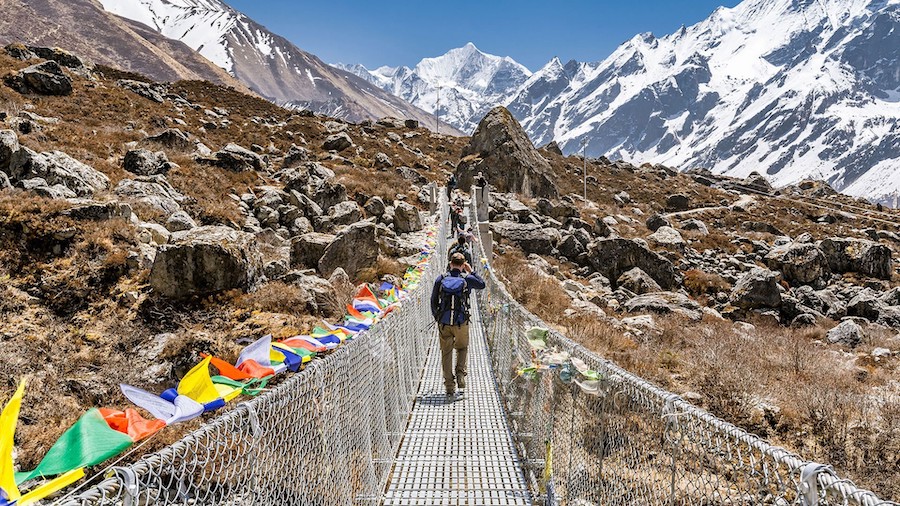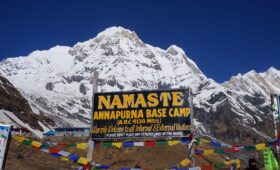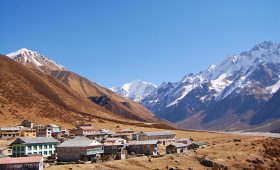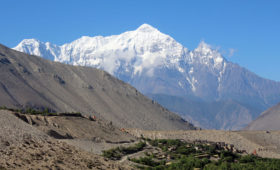Nepal is a popular trekking destination in the world. While trekking in the various terrains of Nepal, you will either do the teahouse trekking or go for Camping trekking. And the price of Teahouse trekking in Nepal is quite different from Camping.
Teahouse trekking is a lot affordable, easier and safer mode of accommodation for the trekkers. You will find many tea houses on the trail which offer you affordable services are they are quite convenient to use while trekking in Nepal.
The trekking routes are famous for its beauty. And the views of the mountains are absolutely breathtaking. You will come across various villages on the trail. You will get an opportunity to learn about the unique culture and traditions of the mountain people.
There are various trekking options to choose from in Nepal. From a month-long adventurous trek to a week-long moderate trek, everyone will find something that will suit their taste.
Price of Tea House Trekking
Teahouse Trek is the most popular style of trekking in Nepal among both foreigners and locals. In a teahouse trek, you stop each night at a tea house to sleep and eat along the trail.
It is a cheap way of trekking where both meals, as well as accommodation, are available in the tea houses itself. It is a great way to trek the great Himalayan trails.
In the past, tea houses were little shops managed and inhabited by the locals of the area where trekkers would stop to rest and drink a cup of tea and snacks.
With time the tea house concept has changed as the number of trekkers have increased.
Trekkers love to stay at the tea houses as it is a rare opportunity for them to explore the culture and traditions. You can also get a glimpse of the daily lives of the local people.
Hence, the tea houses are a booming business in the upper regions of Nepal. Also, developed hotels with better facilities for accommodation, food, and others are also quite popular.
Teahouse trekking will save you from carrying camping equipment like a tent, sleeping bags, and food.
You will also get to trek in peace without having to worry about setting up tents and cooking.
And as for the quality of accommodation and food at the tea house, it varies according to the remoteness of the area.
Tea houses in the Everest and Annapurna region provide good food and accommodation. Whereas teahouses in the lesser popular treks in remote areas provide very basic facilities.
Allow us to discuss the cost of teahouses in different trekking regions of Nepal:
1. Price of Tea House Trekking in Everest Region
Everest Panorama Trek
- Duration: 8 – 11 Days
- Maximum Altitude: 3860 Meters
- Price: USD 785 – USD 1150 p.p. (subject to change as per the size of the group)
Jiri/Bhandar to Everest Base Camp Trek
- Duration: 22 Days
- Maximum Altitude: 5,365 Meters
- Price: USD 14500 – USD 2170 p.p. (subject to change as per the size of the group)
Everest Base Camp Trek
- Duration: 12 – 15 Days
- Maximum Altitude: 5645 Meters
- Price: USD 1260 to USD 1490 p.p. (subject to change as per the size of the group)
Find more Everest Region Treks here.
2. Price of Tea House Trekking in Annapurna Region
Annapurna Base Camp Trek
- Duration: 8 – 15 Days
- Maximum Altitude: 4200 Meters
- Price: USD 775 – USD 1099 p.p. (subject to change as per the size of the group)
Annapurna Circuit Trek
- Duration: 10 – 15 Days
- Maximum Altitude: 5416 Meters
- Price: USD 995 – USD 1285 (subject to change as per the size of the group)
Poon Hill Trek
- Duration: 4 – 7 Days
- Maximum Altitude: 3210 Meters
- Price: USD 464 – USD 685 p.p. (subject to change as per the size of the group)
- Duration: 8 – 12 Days
- Maximum Altitude: 3800 Meters
- Price: USD 700 – USD 1165 p.p. (subject to change as per the size of the group)
Find more Annapurna Region Tea House Treks here.
3. Price of Tea House Trekking in Langtang Region
- Langtang Valley Trek
- Duration: 6 – 10 Days
- Maximum Altitude: 3798 Meters
- Price: USD 570 – USD 785 p.p. (subject to change as per the size of the group)
Helambu Circuit Trek
- Duration: 6 – 8 Days
- Maximum Altitude: 3,650 Meters
- Price: USD 550 – USD 650 p.p. (subject to change as per the size of the group)
Find more Langtang Region Treks here.
4. Price of Tea House Trekking in Restricted Region
Upper Mustang Trek
- Duration: 10 – 14 Days
- Maximum Altitude: 4135 Meters
- Price: USD 1600 – USD 2100 p.p. (subject to change as per the size of the group)
Tsum Valley Trek
- Duration: 12 – 17 Days
- Maximum Altitude: 4665 Meters
- Price: USD 900 – USD 1200 p.p. (subject to change as per the size of the group)
Manaslu Circuit Trek
- Duration: 12 – 14 Days
- Maximum Altitude: 5210 Meters
- Price: USD 1290 – USD 1485 p.p. (subject to change as per the size of the group)
You can find more remote area treks here, as well as newly open treks here.
You will be paying this variety of prices for different types of services you will enjoy at the teahouses while on the trek. The services that the teahouses provide are:
Accommodation in Tea House While Trekking in Nepal
Accommodation is generally pretty much similar in all tea houses. It is normally just a bed with pillows and blankets. Houses do not have any kind of room heating systems, but they will provide you with extra blankets on request.
The rooms are definitely lighted but the lighting could be a bit different than in the cities. In most of the places, they use a solar charger.
You may find a small shelf, coat hooks, a chair, or a small table. This pretty much adds up the ambiance of the room.
Most rooms are on twin sharing basis, meaning there are two beds in a room and you will have to share it with someone. You can also ask to sleep alone in a room, but its availability will depend on the number of trekkers coming in.
The rooms are simple but pretty clean and comfortable. You can even use your sleeping bags or sleeping bag liner for hygienic purposes.
The best thing about sleeping at a tea house is the view from the window of the room early morning. And you won’t even have to bother carrying or unpacking and packing things to set up a camp.
However, the tea houses in the more popular trekking regions are much more standard. You might find facilities like western toilets, hot showers etc.
You might, however, want to bring a pair of earplugs if you are a light sleeper since the walls are thin and the noise from outside might disturb your sleep.
The average cost of a simple room in a tea house is around USD 3-4 a night. But the prices may range from USD 3-10 depending on the elevation, remoteness and the service available in the tea house.
And if you are trekking in the ”off-season” then the rooms will cost you an average of USD 1-2 per night.
Food in Tea House Trekking in Nepal
Food is mostly basic and repetitive in tea houses in Nepal. The food is hygienic, plentiful and delicious. And because the products are mostly local, they are healthy and organic.
The most famous menu on every trekking trail is the authentic Nepalese cuisine ”Dal-Bhat”. It includes a huge serving of steamed rice and sides of curried vegetables, some greens and a bowl of lentil soup.
Each dal bhat served at different tea house is different – some curried, some spicy, some plain, some thicker. So although it’s the same dish, believe me, you will enjoy every bit of it.
And the best thing about dal bhat is that it’s an All You Can Eat! You can refill your plate of dal bhat and eat till you are full. It’s perfect after a long day of trekking when you’re famished.
Another famous menu on the trail is MoMo (dumplings). But since making Mo: Mo’s might take up to 30 minutes it is not an ideal menu to order during the day when you are trekking. You can order it in the evenings after trekking for the day.
The standard menu on trekking trails are:
For breakfast, you will find a menu like this:
- Pancakes: Plain, apple, cinnamon, lemon; served with peanut butter or honey
- Porridge: Oat, Tsampa (barley)
- Eggs: Scrambled, boiled, fried, poached, omelette (plain, onion, vegetable, cheese)
- Bread: Toast, Tibetan, Chapati
For lunch/dinner, the meal of choice is Dal Bhat. It is a huge plate of white rice with small sides of a vegetable or two (often spinach and potato), and a bowl of lentil soup.
If you’re craving for something other than dal bhat, there are plenty of other options for food at tea houses.
The menu will look like this:
- Rice: Dal bhat, fried rice (chicken, vegetable, plain), curried, plain
- Soup: Sherpa stew, chicken, tomato, garlic, mushroom, vegetable
- Noodles: Chowmein, egg fried, spaghetti
- Potato: Boiled, fried, mashed, chips, pancakes
- Other: Pizza, spring rolls, dumplings
On more popular trekking routes, you might find a wide range of options in the menu like Indian, Continental, Chinese, Tibetan etc.
Some tea houses in the popular trekking routes like Everest Base Camp and Annapurna Base Camp even serve desserts. Other than food, tea houses even sell snacks like biscuits, chocolates, fresh fruits.
They also sell various drinks like soft drinks, juices, energy drinks, alcohol, tea, coffee etc.
The availability of meat will vary and is scarce in remote and high altitude areas. They are also relatively more expensive so it is ideal to avoid eating meat during the trekking period.
Other than that, the food served at tea houses are extremely healthy and delicious.
A hearty meal at the start of the trek will cost you about USD 2 but as you go higher it might cost you around USD 10 for a standard meal.
Other than food, various kinds of drinks are also available in tea houses. A bottle of water may cost you USD 50 and it can go up to USD 2 as you reach higher elevation.
A cup of tea or coffee costs USD 2-5.
Other Services in Tea House
Toilets
Flush toilets are rare in the mountains, most toilets are the Indian style squat toilets. Some tea houses may even have rooms with attached bathrooms but most often it is a shared bathroom outside.
You should carry toilet paper as you won’t find it in the mountains.
Hot Showers
Another facility provided by tea houses are hot showers but you will have to pay around USD 2-3 for it. Cold showers are available free of cost.
Charging Phones, Cameras etc
Rooms don’t necessarily come with plug sockets but you can ask to charge your phones, cameras and other electronic gadgets in the common room.
They charge you about USD 1-3 for an hour of using the plug point.
Wi-Fi or other Internet Services
Many tea houses may not have access to the internet in the mountains but if they do, they might charge you around USD 3-5 to use it.
Conclusion
Nepalese tea houses are not just simple lodges set along the way where you’d grab a meal and crash for the night. But they are much more than that – tea houses display the pseudo-culture of the area and are a booming industry in Nepal.
It is an easy and affordable mode of trekking in the Himalayas of Nepal.
There are a lot of options for tea houses and you will definitely find one that suits your budget and taste.
Teahouse trekking gives you an opportunity to experience the livelihood of the local people in the area. You will also enjoy and learn about their traditions and culture.
For further queries and information please feel free to contact us.
Do you have any question about trip to Nepal?
Tell us about your trip to Nepal and what you expect from it. We will answer your questions in 24 hours and help you design a trip with a comfortable itinerary to best meet your needs.





